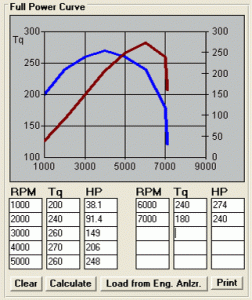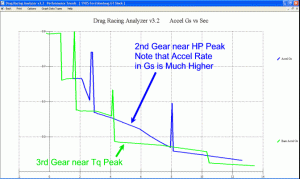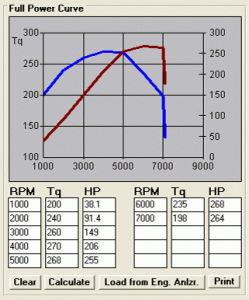You’ve probably heard various racers and engine builders/tuners talk about torque vs HP. Some say “torque is what moves the car”, other’s say HP is all that matters. Well, you’ll have to put me in the latter camp, because HP is the most important. Torque is how much twisting force you are putting on the driveshaft, typically measured in ft lbs. Horsepower is multiplying this twisting force by RPM (how fast you can keep applying this force).
If we didn’t have gears, than torque would be more important. That’s because in any 1 gear, the torque peak is where the car accelerates the quickest, producing the highest Gs. The torque peak can be important for launching the line, but after that HP is all that matters.
I’ll try to illustrate with some numbers. Gears are torque multipliers. You can get most any torque you want, if you are willing to give up RPM. Say you have 400 ft lbs at 3000 RPM (228 HP) and 350 ft lbs at 6000 RPM (400 HP). If you stay in 3rd gear, you could get .4 Gs acceleration at 3000 (lets say 60 MPH) and .35 Gs of acceleration at 6000 (120 MPH). However, if you shifted 1st gear and put that 400 HP to work at 60 MPH, you could get, say .7 Gs of accel. You may accelerate the quickest in any 1 gear at the torque peak, but you will accelerate quicker in a lower gear at the HP peak.
Racing is all about quickest acceleration to get to the highest speed. Gears let you keep the acceleration high by keeping the engine in its highest HP range. In our Drag Race Analyzer and Circle Track Analyzer programs, they find the optimum shift RPMs or final drive ratios by keeping the engine in its highest HP range. For example, if your engine has peak HP at 6000 RPM, but pulls strong to 7000 RPM, you would probably want to shift at close to 7000 RPM, so when the revs drop back to, say, 5000 RPM, you are still in a high HP range.
Let’s try some real examples, using our easy Drag Race Analyzer v3.2. We’ll try shifting to keep the engine around the torque peak, then letting the computer keeping the RPMs around the HP peak.
Condition Pk Tq Pk HP ET MPH Shift RPMs
Keep Engine at Tq Peak 270 274 13.43 99.46 4700
Computer keeps Engine at HP Peak 270 274 12.66 106.81 6800
Computer keeps Engine at HP Peak 270 268 12.60 107.74 6950
(broader HP peak)


Click on image to enlarge it.
You will see a third line in the table of results, where I used a power curve with 6 less peak HP, but a broader HP peak. It shows better performance (12.60 ET) than the curve with more peak HP. This makes the point that it is the “area under the HP curve” which is actually most important, or the highest average HP over the RPM range you are using.Power Curve with Lower, but Broader HP Peak

To summarize, it is HP through the correct gear ratio which produces best performance. If you are building an engine, you want the highest averageHP through the RPM range you will be using. For a circle track car where you don’t shift, this can be a very broad RPM range. For drag racing with a high stall converter or very narrow ratio transmission, this may be a very narrow RPM range. The Performance Trends vehicle programs like Drag Race Analyzer (std or Pro version), Circle Track Analyzer, or Transmission Gear Calculator will help you optimize your engine and vehicle combo.